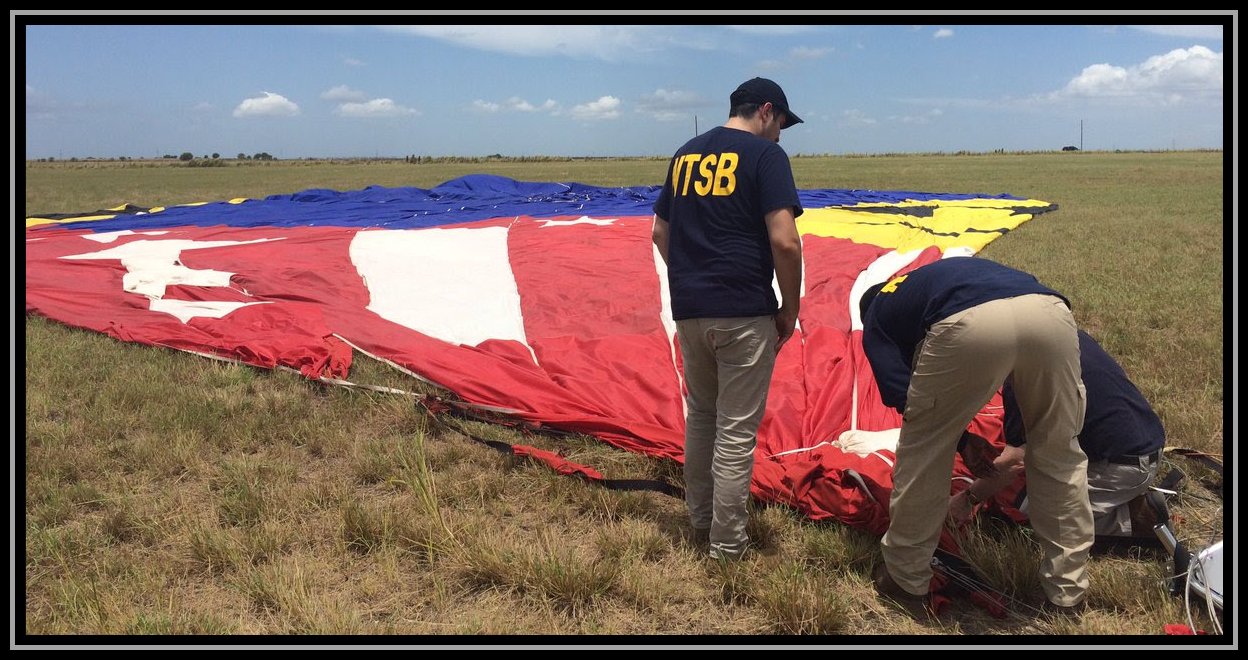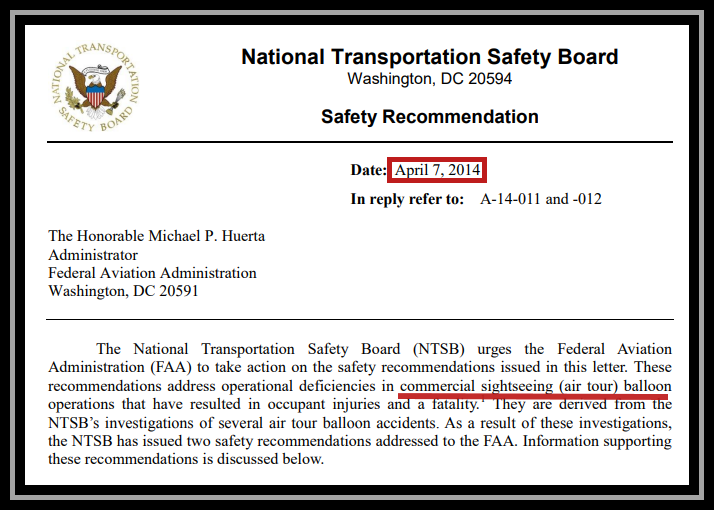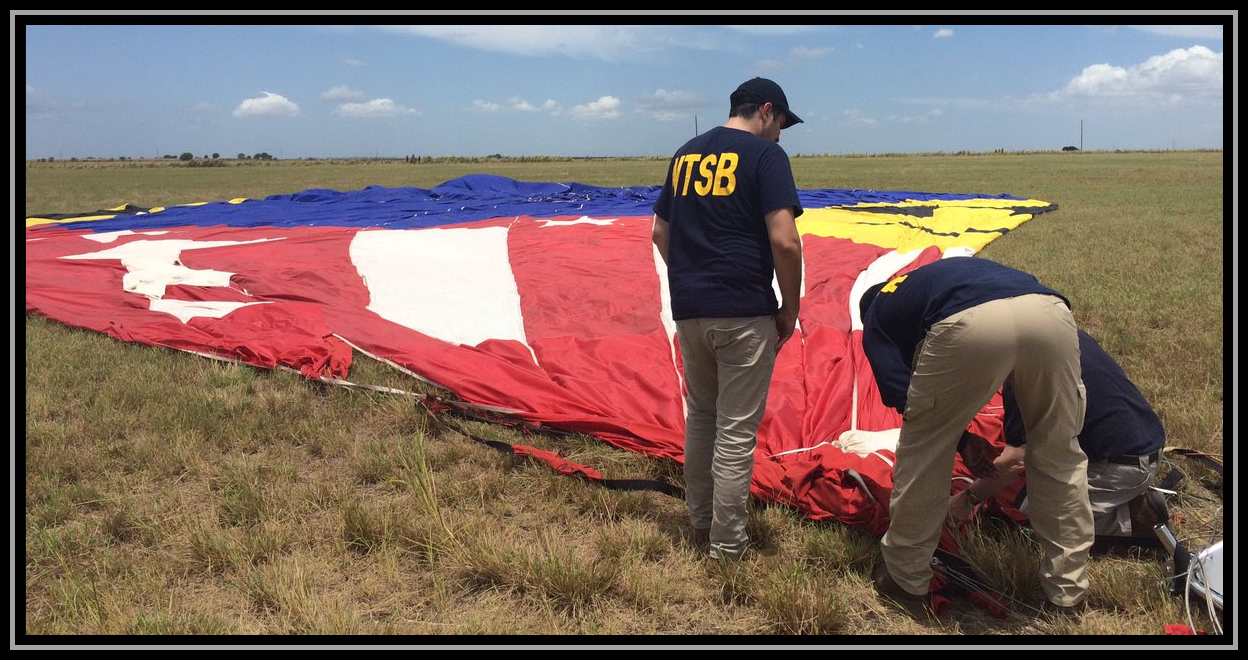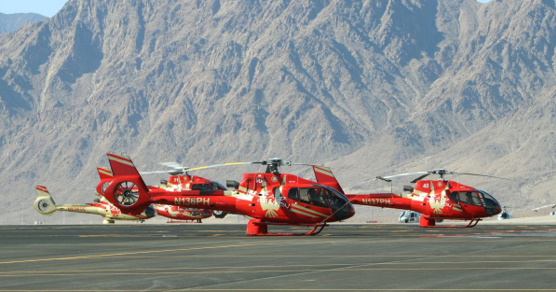Balloon and Flightseeing Operators- Part 135 coming! Get ahead before the rush.

A recent Arizona article reports on the FAA’s response to decades old NTSB recommendations concerning Hot Air Balloon flights. These operations, as well as FlightSeeing tours are permitted under the less restrictive 14 CFR Part 91 rules. Coincidentally, AINonline wrote that the Senate version of the FAA Reauthorization Act (S.1939) includes provisions that would require that these exceptions to the GA Regulations no longer apply to their offerings. The Senate answer would mandate that the heavier safety requirements of 14 CFR Part 135 would be applied.
N.B. THE SENATE AND THE HOUSE ARE IN CONFERENCE DECIDING WHAT DIFFERENCES WILL BE INCLUDED IN THE ACTUAL LEGISLATION. The Senate version includes some HIGH PROFILE Sections that will draw considerable attention and debate. The Hot Air Balloon and Flight Seeing changes have drawn considerable fire from their respective trade associations.
One knowledgeable observer of these Congressional contests suggests that these Senate changes may be included in the joint legislation. The fact that the NTSB has repeatedly recommended that Part 135 apply to these passengers who pay, and their imprimatur may carry the day.
The AZ article’s last paragraph is a “quote” from the FAA has set setting new rules of these types of operations as a PRIORITY.
An application for a Part 135 certificate does require time and resources; however, a knowledgeable guide can expedite the process. Having been through these interactions, such a guide can facilitate the production of the required policies, procedures, and manuals.

Why should anyone act NOW? Neither Congress nor the FAA has acted!!! True, but this Administration has made it clear that ELEVATING SAFETY STANDARDS is its most common outcome in almost all the policies that they have faced.
At the same time, those who are familiar with the FAA staff, local and national, know that the requests for Part 135 certificates exceed the human resources assigned to these tasks. The line of applicants starts at FSDOs’ doors and winds around all 4 sides.
What is not known is what the FAA will do when, not if, hot air balloon and flightseeing operators are bound by the P135 requirements. Must these services be suspended while waiting for the requisite approval?
One way to avoid this regulatory approval delay is to anticipate the inevitable and start now. FAA has established a new policy that rewards those applicants that provide a well-designed and fully compliant set of applicant documents package (N 8900.687, dated 01/19/2024). Beginning now may create a COMPETITIVE ADVANTAGE.

NTSB says hot air balloon pilots need more oversight, why hasn’t it happened?

The NTSB, has been calling for more regulation and oversight of hot air balloons and their pilots for at least 17 years.
By Amy Cutler and Cody Lillich
PHOENIX (3TV/CBS 5) — It’s been a month since four people were killed and a fifth seriously injured in a hot air balloon crash in Eloy. Hot air balloon rides have become increasingly popular in and around the Valley. But how safe are they? It’s the question Arizona’s Family Investigates has spent the last few weeks trying to answer.
The National Transportation Safety Board, or NTSB, has been CALLING FOR MORE REGULATION AND OVERSIGHT OF HOT AIR BALLOONS and their pilots for at least 17 years. But they only investigate crashes and recommend changes; it’s up to the FAA AND CONGRESS TO ACT, and on most of these, they haven’t.

Rosemarie Gregorio knows the dangers hot air balloons can pose all too well. Her husband was killed in the last fatal hot air balloon crash in Marana back in 2005. She and her husband had received the ride as an anniversary gift from their daughter. “We hit some cables, electrical cables, and the balloon caught fire and I passed out again… The next thing I remember is the balloon dragging on the ground. My face was in the dirt,” Rosemarie explained.
She calls her husband, Thomas, the love of her life. Eleven people were on that balloon that April day in 2005. The NTSB’s final report found the basket hit several boulders along the side of mountains. “My whole body was black and blue for months,” Rosemarie said.
Rosemarie was one of three people seriously injured in that crash. “I was screaming, my husband is dead… He was the nicest man you could imagine, right. Papa was good. Gentle, real Italian boy,” she explained.
This crash in Marana was ONE OF 30 THE NTSB INVESTIGATED IN ARIZONA SINCE 2000. You might remember one close call from December in North Phoenix where a balloon with nine people onboard came down on a light pole.
The most recent accident was in Eloy back in January. “The standards, I’m not going to say they’re unsafe, but they’re a little lower than some of the other areas out there, and unfortunately, because of that, that’s led to challenges and sometimes accidents,” Anthony Brickhouse, an aviation expert and Associate Professor with Embry-Riddle Aeronautical University said.
He explained the NTSB has been calling for more oversight of this industry for nearly two decades. Hot air balloons fall under Part 91, which is known as Revenue Passenger-Carrying Operations.
It took until 2016, with the deadliest hot air balloon crash in the U.S., for the issue to be put in the spotlight. Sixteen people were killed, including the pilot in Lockhart, Texas, when the balloon hit power lines. We’d later learn the pilot had served two prison sentences for drug and alcohol-related offenses and had several prescription drugs in his system at the time of the crash.
“This is figure out what the gaps are in your oversight and address them,” JENNIFER HOMENDY said during an NTSB board meeting in March 2021. The agency was so concerned they commissioned a report on the issue. It recommended closing loopholes, developing national safety standards, and a database for these operators.
“This should be a matter of just taking action,” Homendy explained. Homendy has since become the chair of the NTSB, and she’s continued to call on the FAA and Congress to act.
To date, only ONE RECOMMENDATION from their report on the Lockhart crash has been adopted. It requires balloon pilots to have additional medical clearance or what’s known as a second-class medical. “If you have people onboard, you should definitely be of a certain level of health,” Brickhouse said.
Arizona’s Family Investigates found records that show the pilot in the Eloy crash did have a medical certification. It’s a move the Balloon Federation of America or BFA, a trade group that advocates for the ballooning industry, remains opposed to. “We have people that have been flying safely for 20, 30, 40 years… Now they’re in their 50s and 60s in some cases, and they have to go for the very first time to get an FAA second-class medical, and that’s not an easy process. The applications are somewhat daunting,” said Pat Cannon, the President of the BFA.
He argues more regulation isn’t the answer. “You cannot mandate attitude; you cannot mandate decision and judgment-making process,” Cannon said. “We should take this opportunity to strengthen safety for all passengers,” Homendy said to a Congress subcommittee last February.
Arizona’s Family Investigates asked Brickhouse what he thought it would take for the FAA or Congress to act. “Well what we don’t want is to have to have more accidents,” he responded. “Why should people die for somebody’s mistake? That could probably be corrected or improved,” Rosemarie said.
Arizona’s Family Investigates also reached out to the FAA for a response. A spokesman writes, “THE FAA HAS IDENTIFIED PART 91 REVENUE PASSENGER-CARRYING OPERATIONS AS A RULEMAKING GOALIN ITS RULEMAKING PRIORITIZATION PLAN AND IS CURRENTLY DEVELOPING RULEMAKING PROPOSALS FOR CONSIDERATION THAT MAY ADDRESS THESE SAFETY RECOMMENDATIONS.”

Senate FAA Reauthorization Mandates Part 135 for All Air Tours
Alphabets urge rejection of costly new Part 135 provisions

Papillon EC130s on the ramp at Boulder City, Nevada. (Photo: Barry Ambrose)
By MARK HUBER • Contributor – Rotorcraft
February 19, 2024
The U.S. Senate version of the FAA Reauthorization Act (S.1939) passed earlier by the Commerce Committee this month would require NONSTOP SIGHTSEEING AND SKYDIVING FLIGHTS TO BE OPERATED UNDER PART 135, provisions not contained in the version of legislation passed in July by the House of Representatives (H.R. 3935). Those operations historically have been conducted via FAA issuance of a letter of authorization under Part 91.147.
This morning, aviation alphabet groups including the Aircraft Owners and Pilots Association, Experimental Aircraft Association, U.S. Parachute Association, and the Commemorative Air Force urged leaders of the House Transportation and Infrastructure Committee and its Aviation Subcommittee to remove these provisions from the final version of the legislation as it is considered during a House-Senate conference. The groups warned that if the Senate bill were enacted, it would “have significant and insurmountable direct impacts on thousands of small general aviation businesses and the airports at which they operate” and would “negatively impact those conducting air tours and sport parachuting operations.”
Citing the HIGH COSTS AND REGULATORY BURDEN associated with obtaining and maintaining a Part 135 certificate, the groups maintained that the requirement “would be nearly impossible and financially unattainable for these small businesses, resulting in their likely closure.” They also claimed that it would overburden the FAA, tax its already limited resources, and be harmful to its overall mission of aviation safety.